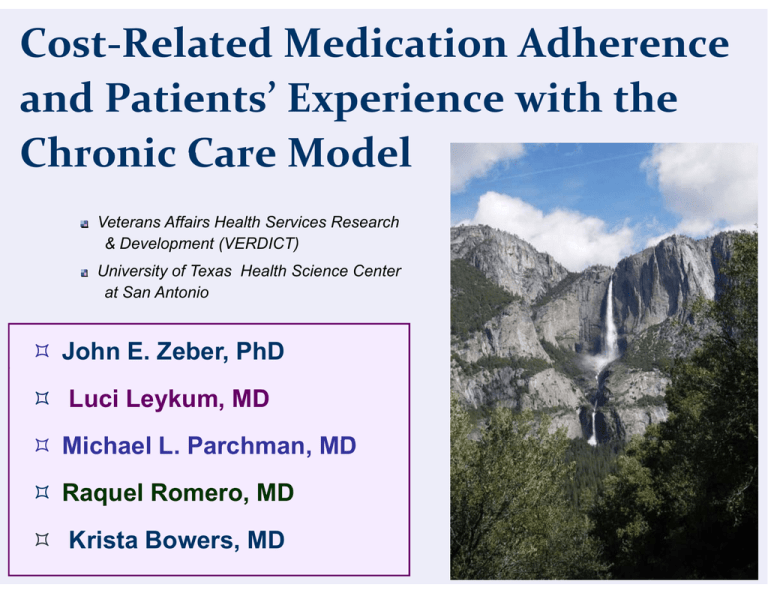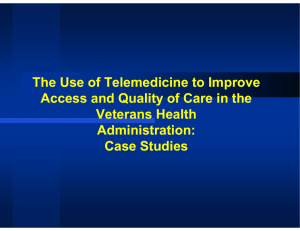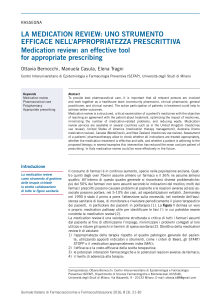Cost‐Related Medication Adherence and Patients’ Experience with the Chronic Care Model
advertisement

Cost‐Related Medication Adherence and Patients’ Experience with the Chronic Care Model Veterans Affairs Health Services Research & Development (VERDICT) University of Texas Health Science Center at San Antonio John E. Zeber, PhD Luci Leykum, MD Michael Mi h l L. L Parchman, P h MD Raquel Romero, MD Krista Bowers, MD The communication and coordination di ti off scattered tt d ffragments t of knowledge is perhaps the basic problem of any society - Thomas Sowell It seems rather incongruous that in a society of super-sophisticated communication we often suffer communication, from a shortage g of listeners - Erma Bombeck “And that one’s for the relief of anxiety caused by the high cost of medication” Introduction Medication adherence is a significant concern for patients ti t with ith chronic h i h health lth conditions diti ((~40%) 40%) Scenario frequently q y exacerbated by y financial considerations (15-20% restrict Rx due to cost) 1-2 Age, ethnicity, Age ethnicity multiple comorbidities, comorbidities and severity of illness compounds the problem Fortunately, provider and organizational factors can mitigate g medication cost burdens 1 - Piette et al., AJPH 2004; 2 – Maciejewski et al., AJMC 2010 Implementation of CCM can yield more activated patients (CVD behaviors more engaged in their own TX (CVD, behaviors, A1c – bunch of Parchman et al. stuff) Such patients have better adherence, therefore leading to significantly improved clinical outcomes illness insight, therapeutic alliance and other psychosocial barriers 3-5 trust in physicians 6 self-activation and communication 7 alliance and cost burden 8 3 – Copeland et al., J Nerv Ment Dis 2008; 4 – Zeber et al., J Aff Dis 2008; 5 – Zeber et al., Adm Policy MH (in press); 6 – Piette at al., Arch Int Med 2005; 7 – Parchman et al., Ann Fam Med (in press); 8 – Zeber et al., 2009 (conference abstract) p = .013 Better CCM Delivery y = Lower A1c 8.2 8.1 8 7.8 7.8 Mean A1c 7.6 7.4 7.4 72 7.2 7 Low Medium Chronic Care Model Score p <.01 High Objectives Research Purpose: 1) This study examines the association between patients’ experience of the CCM and reported patients cost-related medication adherence burden 2) Share some quantitative findings concerning the CCM PCMH overlap Methods & Studyy Design g ABCs project: main objective = help facilitate the implementation of the Chronic Care Model / PCMH in small community clinics and risk factors for diabetes complications A = A1c B = Blood pressure C = Cholesterol Primary goal is determining how practice facilitation efforts can influence better implementation of the CCM ABCs: a conceptual model Facilitation efforts & Toolkit of Strategies “Toolkit” Leadership Communication Learning Implementation of CCM / PCMH Improved A1c control and other clinical outcomes ↑ Activation / Self-engagement ↑ Medication Adherence Population Studied: Patients with chronic medical illness at 40 small, primary care offices in South Texas Randomized trial: initial intervention group (20) and delayed control group (20) Complex C l study: t d observations, b ti ffacilitation ilit ti sessions, i provider and staff interviews, patient surveys, chart reviews, dissemination study we utilized patient survey data only: For this study, 60 randomly selected patients per clinic Measures & Analysis Cost-related adherence burden (CRAB) was measured with a 5 5-item item scale (Piette et al.) higher scores reflect more medication restrictions Patient Assessment of Chronic Illness Care (PACIC) 9 20 item instrument assessing perceptions of primary care 20-item treatment; higher values = care more consistent with CCM Random effects models controlled for nesting of patients, plus demographics p g p 9 – Glasgow et al., Med Care 2005 Results To date, 1368 patients completed both baseline surveys P ti t characteristics: Patient h t i ti mean age = 50.1 years 65% women, approximately 50% Hispanic overallll self-reported good lf t d health h lth status: t t d = 75% poor medication adherence = 45%, with nearly 30% claiming some cost-related problems. CRAB scale mean was 1.50 1 50 (sd 0.82) 0 82), with an overall PACIC mean of 3.02 (sd 1.25) Table 1: Study Population Characteristics (n = 1368) Age mean (sd) Age, Women Race / Ethnicity % White % Hispanic % African-American % Other Education high school grad or less Education, Health status, good, very good / excellent Poor medication adherence (Morisky) Satisfaction with care, very (highest score) Ever restricted medication due to cost PACIC mean (sd) PACIC, ( d) Medication cost burden (CRAB), mean (sd) Diabetes diagnosis Major depression diagnosis Other chronic health condition 50.1 (17.4) 65.7% 38.9% 50.1% 4.7% 6.3% 45 2% 45.2% 74.6% 45.3% 66.3% 28.9% 3 02 (1.25) 3.02 (1 25) 1.50 (0.82) 27.0% 12.9% 51.1% Multivariable models: CRAB was inversely associated with the total PACIC score (OR = 1 1.17) 17) i.e., ↑ CCM delivery, ↓ cost-related cost related problems also, higher subscales scores for: patient activation (OR = 1.26) problem solving (OR = 1.16) practice design (OR = 1.26) 1 26) Figure 1: Multivariable Model Predicting No CRAB PACIC Total (OR=1.17) Patient Activation (OR=1.26) Care Coordination (OR=1 (OR=1.05) 05) Problem Solving (OR=1.16) Goal Setting (OR=1.04) P ti D Practice Design i (OR (OR=1.26) 1 26) 0 02 0.2 04 0.4 06 0.6 08 0.8 10 1.0 12 1.2 14 1.4 16 1.6 18 1.8 20 2.0 Odds Ratio (OR) – per point change in PACIC score * models controlled for age, gender, ethnicity, and education Discussion Patients experiencing care more consistent with the chronic care model had lower cost-related cost related burden Being actively involved in clinical decisions and provided i f information ti about b t their th i care → added dd d b benefits fit While prevalence and factors influencing poor adherence are widely understood, cost burdens are less appreciated Efforts to develop highly activated activated, involved patients can help mitigate ramifications of financial pressures Community providers should better recognize and discuss medication cost burdens while focusing treatment efforts in accordance with chronic care treatment delivery Overlap Between CCM and PCMH Comprehensive First Contact Primary Care SelfManagement Support Decision Support Clinical Information Systems Patient-Centered Medical Home Community Linkages Wagner CCM What s What’s Included? (Infrastructure) How Much Used? (Extent) What Evidence Functions? (Implementation) Comparing the PCMH and CCM THE PCMH Standards THE CCM 1. Access & Communication Delivery System Design 2. Patient Tracking & Disease Registry Clinical Info Systems & Decision Support 3. Care Management Decision Support & Delivery System Design 4. Self-Management Support Self-Management Support 5. Electronic Prescribing g Clinical Information Systems y 6. Test Tracking Delivery System & Clinical Info System 7. Referral Tracking Delivery System & Clinical Info System 8. Performance Reporting and Improvement Organizational Support & Clinical Information Systems 9. Advanced Electronic Communication Clinical Information Systems Quantitative Associations: CCM & PCMH association between patient (PACIC) and provider (ACIC) assessments of chronic care model: answer - very low Dr. Parchman and colleagues constructed a PCMH “score” f from provider id surveys b based d upon th the NCQA categories: t i not recognized (<25), Level I (25 - 49), Level II (50 - 74), or Level III (75+) range 3 - 61; mean = 28 28.4; 4; 54% = not; 31% = 1; 15% = 2 ** no multivariable association between estimated PCMH & CCM (p=0.28) Implications p for effective implementation, p , reconciling g priorities, enhancing therapeutic alliance, etc. John Zeber, PhD Veterans V t Affairs Aff i HSR&D (VERDICT) San Antonio, TX Assistant Professor UTHSCSA Dept. of Psychiatry * study supported by the National Institute of Diabetes, Digestive and Kidney Disorders (R18 DK 075692) zeber@uthscsa.edu @ Michael L. Parchman, MD (study PI) parchman@uthscsa.edu


